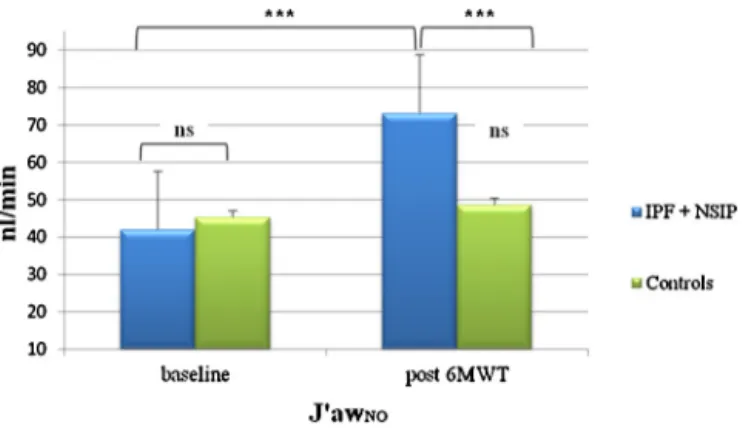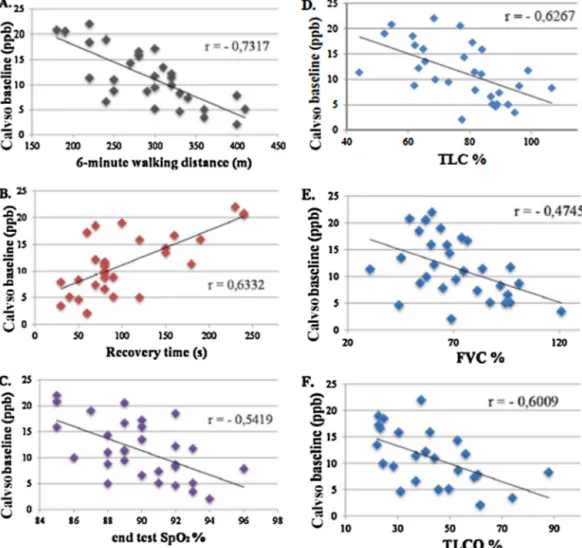ContentslistsavailableatScienceDirect
Respiratory
Physiology
&
Neurobiology
j o u r n a l ho me p ag e :w w w . e l s e v i e r . c o m / l o c a t e / r e s p h y s i o l
Exhaled
nitric
oxide
in
interstitial
lung
diseases
P.
Cameli
∗,
E.
Bargagli,
R.M.
Refini,
M.G.
Pieroni,
D.
Bennett,
P.
Rottoli
DepartmentofMedicalandSurgicalSciencesandNeurosciences,RespiratoryDiseaseandLungTransplantationSection,LeScotteHospital,Siena,Italy
a
r
t
i
c
l
e
i
n
f
o
Articlehistory: Accepted21March2014 Availableonline2April2014 Keywords:
Nitricoxide
Idiopathicpulmonaryfibrosis Non-specificinterstitialpneumonia biomarker
Oxidativestress Nitrosativestress
a
b
s
t
r
a
c
t
Nitricoxide(NO)isabiomarkerofnitrosativestress,whichisinvolvedinthepathogenesisofidiopathic interstitialpneumonias(IIP).ThisstudyevaluatesexhaledNOlevelsinIIPpatientsandrelates alveo-larconcentrationsofNO(CalvNO)topulmonaryfunctiontest(PFT)and6-minutewalkingtest(6MWT)
parameters.Wemeasuredfractionalexhalednitricoxide(FeNO),CalvNOandmaximumconducting
air-waywallflux(J’awNO)in30healthysubjectsand30patientswithIIP(22idiopathicpulmonaryfibrosis
and8idiopathicnon-specificinterstitialpneumonias).IIPpatientshadhigherFeNOatflowratesof 50–100–150ml/sandhigherCalvNOlevelsthanhealthycontrols(p<0.0001).CalvNOwassignificantly
correlatedwith6-minutewalkingdistance(p<0.0001),recoverytime(p<0.0005),TLC(p<0.001),FVC (p=0.01)andTLCO(p<0.01).IIPpatientsshowedabnormalnitricoxideproduction,probablyduetolung fibrosisandoxidative-mediatedlunginjury.CalvNOwascorrelatedwithPFTand6MWTparametersand
isproposedasapotentialbiomarkeroflungfibrosisandexercisetolerance.
©2014ElsevierB.V.Allrightsreserved.
1. Introduction
Nitricoxide(NO)isamoleculeproducedbythehumanlungs
andispresentinexhaledbreath.Itplaysahomeostaticroleina
widerangeofphysiologicalprocesses.Sincetheearly1990s,
sys-temsformeasuringNOin exhaledbreathhave beendeveloped
andusedtomeasurethefractionofexhalednitricoxide(FeNO)
inmanylungdiseases,includingasthma,chronicobstructive
pul-monarydisease(COPD),cysticfibrosis,primaryciliarydyskinesia
andpulmonaryarterialhypertension(AmericanThoracicSociety
EuropeanRespiratorySociety,2010).TheanatomicaloriginofNO
productioncanbeseparatedusingatwo-compartmentmodelof
the lung (airway and alveolar compartments) and partitioning
NOintoalveolarconcentrationofexhaledNO(CalvNO)and
max-imumconductingairwaywallflux(J’awNO)(TsoukiasandGeorge,
1998).Atpulmonarylevel,NOactsasavasodilator,bronchodilator,
Abbreviations: NO,nitricoxide;eNO,exhalednitricoxide;FeNO,fractionof exhaledNO;VeNO,exhaledNOoutput;CalvNO,alveolarconcentrationofNO;J’awNO,
maximumconductingairwaywallflux;IPF,idiopathicpulmonaryfibrosis;BAL, bronchoalveolarlavage;NSIP,non-specificinterstitialpneumonia;PFT,pulmonary functiontests;6MWT,6-minutewalkingtest;TLC,totallungcapacity;FVC,forced vitalcapacity;TLCO,transferfactorofthelungforcarbonmonoxide;COPD,chronic obstructivepulmonarydisease;IIP,idiopathicinterstitialpneumonia;2CM, two-compartmentmodel;TMAD,trumpetmodelofaxialdiffusion.
∗ Correspondingauthor.Tel.:+390577586710/+393297856833; fax:+390577280744.
E-mailaddress:[email protected](P.Cameli).
neurotransmitterandinflammatorymediator.Itisinvolvedin
sev-eralpathologicalconditions,includingfibrogenesisandoxidative
stress.NOistheprincipalreactivenitrogenspeciesencountered
invivo,andathighconcentrationscausestoxicitybycombining
withsuperoxide anion to produce peroxynitrite.This molecule
maycause nitration(additionof −NO2)ofmost classesof
bio-logicalmolecules,determiningproteindysfunction,inhibitionof
mitochondrialrespirationandDNAdamage.Experimentalstudies
supporttheroleofoxidativeandnitrosativestressinthe
patho-genesisofinterstitiallung diseases(ILD),thoughfewstudieson
exhaledNOanalysisareavailableforidiopathicinterstitial
pneu-monia (IIP) and particularlyidiopathicpulmonary fibrosis (IPF)
patients(Chapmanetal.,2010;Chowetal.,2012;Hua-Huyetal.,
2010;MoodleyandLalloo,2001).Inparticular,Pullamssettietal. (2011)notedapotentialroleofNOinIPF.IPFandidiopathic
non-specificinterstitialpneumonia(NSIP)withfibrosingpatternarethe
mostcommonidiopathicinterstitialpneumonias:theyare
charac-terizedbyapoorprognosis(3–5yearssurvivalforIPF),duetothe
chronicprogressiverestrictivefunctionalimpairmentofthelung,
causedbyfibroticdegenerationofthelungparenchyma.Inaddition
tothat,IPFandNSIPpatientsearlydevelopasevereimpairmentof
physicaltolerance,duetoprogressivehypoxemia,whichseriously
deterioratestheirperformancestatusandqualityoflife.Inorder
toanalyzethisperspectiveinthesepatients,theuseof6-minute
walkingtest(6MWT)hasbeenalreadyvalidatedinIPF,becauseof
itssafetyanditspracticality:therefore,unlikemaximal
cardiopul-monaryexercisetesting,6MWTcanbeperformedbyalmostall
patientsand,becauseitisself-paced,isbettertoleratedandmore
http://dx.doi.org/10.1016/j.resp.2014.03.011 1569-9048/©2014ElsevierB.V.Allrightsreserved.
reflectiveofdailyactivitiesthanotherfunctionaltests:Muraetal. (2012)hasdemonstratedthat6minwalkdistanceatthetimeof
diagnosisisasignificantpredictorofsurvivalinIPFpatients.The
progressofthesediseasesisalsounpredictableatthetimeof
diag-nosis,sotheneedfor newseveritybiomarkersthatcanpredict
thenaturalhistoryandthephysicaltoleranceofthesepatientsis
intenselyfelt
Regardingotherdiffuselungdiseases,Tievetal.(2012)reported
increasedproductionofalveolarnitricoxideassociatedwithlung
fibroblastproliferationinpatientswithpulmonaryfibrosis
associ-atedwithsystemicsclerosisandproposedCalvNOasanon-invasive
biologicalmarkerofalveolitispredictiveofdeteriorationoflung
function.Evaluation ofNO in exhaledbreath condensatesfrom
patientswithsarcoidosis(amultisystemgranulomatousdiseaseof
unknownetiology,inwhichinflammationcanplayafundamental
physiopathologicalrole,onlyevolvingtodiffusepulmonaryfibrosis
inaminorityofpatients)hasproducedconflictingresults.Moodley
etal.(1999)reportedhigherconcentrationsofFeNOinexhaled
breathsamplesfrom12patientswithsarcoidosisthanincontrols,
whileWilsheretal.(2005)describedcontraryfindingsinacohort
of52patients.Choietal.(2009)failedtofindanysignificant
dif-ferencesinFeNOconcentrationsbetweenpatientswithsarcoidosis
andhealthynon-smokercontrols,howevertheyreported
signifi-cantnegativecorrelationsbetweenCalvNOandpercentagevaluesof
forcedvitalcapacity(FVC)andtransferfactorofthelungforcarbon
monoxide(TLCO).Theauthorsconcludedbynotrecommending
exhaledFeNOdetectioninroutineclinicalpractice,duetothelarge
inter-subjectvariabilitytheyfound.HigherCalvNOlevelshavealso
beenreportedin pneumoconiosispatientsthanincontrols, and
exhaledNOhasbeenproposedasapotentialclinicalbiomarkerof
silica-andasbestos-exposedsubjectssusceptibletosilicosis(Fubini
andHubbard,2003;Saunietal.,2012)andasbestosis(Lehtimäki etal.,2010).
AslimitedliteratureisavailableonexhaledNOlevelsinpatients
withidiopathic interstitialpneumonias (Furukawaet al., 2011;
Schildge,2011;Zhaoetal.,2012),wedesignedthepresentstudyto
compareexhaledFeNOconcentrationsofpatientswithidiopathic
pulmonaryfibrosisandnon-specificinterstitialpneumonia with
thoseofapopulationofhealthysex-andage-matchedcontrols,
inordertocontributetothestudyofFeNOinIIP.Instead,toour
knowledge,noliteratureisavailableontheeffectofmildphysical
exerciseinexhaledNOlevelsinIPFandNSIPpatients.Forthis
rea-son,tobettercharacterizethepatternofNOinfibroticpatients,we
alsoexaminedeNOparametersatrestandafterthe6-minute
walk-ingtest(6MWT)inrelationtoreducedphysicaltolerance(which
influencesqualityoflifeandthereproducibilityoflungfunction
tests).
2. Materialsandmethods
2.1. Studypopulationandstudydesign
ThirtyILDpatientswereenrolledinthestudythatwas
per-formed at Siena Regional Referral Centre for Sarcoidosis and
InterstitialLungDiseasesbetweenSeptember2012andMay2013.
Twenty-twopatientshadidiopathicpulmonaryfibrosis(17males,
meanage64±10years),andeightpatientshadidiopathic
non-specific interstitialpneumonia withfibrosing pattern (2males,
mean age63±9 years). Diagnosis wasperformed accordingto
international guidelines (Raghu et al., 2011) and all patients
underwentpulmonaryfunctiontests(PFT),includingsingle-breath
diffusingcapacity forcarbon monoxideatdiagnosisandalmost
every six months thereafter. An accurate medical history was
obtainedfromallpatientsinordertoevaluateprofessional
expo-sure,smokingand medicationhistory. Chestx-raysweretaken
inposterior-anteriorandlateralprojections.Highresolution
com-putedtomographyofthechestwasperformedinallpatientsfor
diagnosticpurposes.Allpatientsandcontrolswereaskedto
per-formacomplete6-minutewalkingtest(6MWT).NineIPFpatients
were non-smokers and 13 were ex-smokers (mean packs/year
10.27±12.23).SixNSIPpatientswerenon-smokersandtwoNSIP
patients were ex-smokers (mean packs/year 5.62±10.5). The
patientshadnohistoryofatopy,concomitantasthma,canceror
autoimmunedisorders,andNSIPsecondarytosystemicsclerosis
orrheumatoidarthritiswasspecificallyexcluded.Atthemoment
ofNOdetection,patientswithIPFandNSIPwereinstablephaseand
hadbeenfreeofrespiratoryinfectionsand/oracuteexacerbations
foratleast4weeks.
The control group included 30 healthy volunteers (16
male, mean age 62±4.73 years), 15 non-smokers and 15
ex-smokers (mean packs/year 5.25±7.2). Patients treated with
phosphodiesterase-five inhibitors and ICS were excluded. All
healthyvolunteershadnormallungfunctionandhadsufferedno
respiratorysymptomsorinfectionsinthelast4weeks.Allpatients
and controlsgave theirwritteninformed consenttothe study,
whichwasapprovedbythelocalethicscommittee,andall
por-tionsofthestudywereperformedaccordingtotheDeclarationof
Helsinki.
2.2. Studyprotocol
Participantswereaskedtoavoidalcoholicdrinks, coffeeand
otherfoodorbeveragescontainingcaffeine(cola,tea,cocoa)for
atleast3hbeforetheexamination.Theyalsohadtoabstainfrom
foodscontainingnitrates(lettuce,spinach,cabbage,sausages)and
high-fatfoodsfor atleast12hbeforetheexamination.Patients
onbronchodilatorshadtosuspendtherapy 12hbeforethetest.
All participants had a mouthwash with water just before the
test.Baselinedeterminationofsystolicpressure,diastolicpressure,
heart rate,pulsed arterialoxygensaturationand exhaled nitric
oxidemeasurementswere takenafter10minofrestin a quiet
andcomfortableenvironment.Allsubjectsthenperformeda
com-plete6MWT,afterwhichexhalednitricoxidemeasurementswere
repeatedwithin5min.IPFandNSIPpatientsalsounderwentPFT
onthesameday.
2.3. Pulmonaryfunctiontests
The following lung function measurements were recorded
accordingtoATS/ERSstandards(Milleretal.,2005),usingaJaeger
BodyPlethysmographwithcorrectionsfortemperatureand
baro-metric pressure: forced expiratory volume in the first second
(FEV1), forcedvitalcapacity(FVC),FEV1/FVC,totallungcapacity
(TLC),residualvolume(RV),carbonmonoxidelungtransferfactor
(TLCO)andcapacitycarbonmonoxidelungtransferfactor/alveolar
volume(TLCO/VA).Allparameterswereexpressedaspercentages
ofpredictedreferencevalues.TLCOmeasurementcouldnotbe
per-formedinfourpatientswhowereonoxygentherapy.PFTswere
performedatleast2hafterexhaledNOmeasurements.
2.4. Six-minutewalkingtest
IPFandNSIPpatientsandcontrolsperformedthesix-minute
walkingtestaccordingtothestandardsoftheATS/ERSguidelines
(ATSStatement,2002).
2.5. Exhalednitricoxidemeasurements
Nitricoxidewasmeasuredusingachemiluminescenceanalyzer
(modelHypairFeNOmedisoftCardiolineExp’air,2010)according
toATS-ERSrecommendationsforonlinemeasurementofFeNOin
Table1
Demographicfindings,clinicalfeatures,6MWTparameters,lungfunctiontestparametersincludingTLCOinpatientswithIPFandNSIPpatientscomparedthancontrols.
Parameters IPF NSIP Controls p-Value
No. 22 8 30
Age(aa) 64.81±10.45 63.25±9.48 62±4.73 ns
Male(n) 17(59%) 2(25%) 16(51%) ns
BMI(kg/m2) 26.25±3.49 27.65±2.51 25.9±2.9 ns
Tobaccouse(pack/year) 10.27±11.8 5.62±10.5 5.2±7.2 ns
SystolicPA(mmHg) 125±12.23 123.75±10.26 121.3±11.9 ns DiastolicPA(mmHg) 73.18±10.86 75±9.25 72.6±9.8 ns Heartrate(bpm) 78.95±11.63 76.5±5.2 73±9 ns SpO2% 95.4±1.14 95.7±2.3 97.6±0.9 <0.001† 6MWT baselineSpO2% 95.2±0.94 95.87±1.88 97.4±0.6 <0.0001*
endtestSpO2% 89.63±2.92 90.5±2.32 96.5±1.8 <0.0001*
baselineHR(bpm) 77.5±8.4 78.75±6.4 71.9±8.4 <0.0001*
posttestHR(bpm) 100.36±17.49 100.87±12.11 85±10.9 <0.0001*
Walkdistance(m) 297.72±55.02 282.5±73.63 366.8±39 <0.0001*
SpO2recoverytime(s) 110.9±59.19 88.75±65.56 7.6±11 <0.0001*
Borgindexbaseline 0.68±1.24 0.75±1.48 0 <0.0001*
Borgindexposttest 4±2.37 5.25±2.96 0.4±0.8 <0.0001*
PFT(%referencevalues) FVC% 69.52±18.15 77.71±25.51 ns‡ FEV1% 69.95±18.33 76.81±25.82 ns‡ FEV1/FVC% 78.22±9.44 78.96±8.64 ns‡ ITGV% 88±16.72 91.31±26.52 ns‡ RV% 92.51±18.06 93.03±25.74 ns‡ TLC% 77.45±14.95 76.47±16.36 ns‡ RV/TLC 48.29±8.19 48.21±8.75 ns‡ TLCO% 43.33±16.65 41.06±21.25 ns‡ TLCO/VA% 68.51±19.22 59.81±11.07 ns‡
Lungfunctiontestareexpressedaspercentagesofpredictedvalues:FVC,ForcedVitalCapacity;FEV1,ForcedExpiratoryVolumein1s;ITGV,IntrathoracicGasVolume;RV,
ResidualVolume;TLC,TotalLungCapacity;TLCO,TransferFactoroftheLungforCarbonMonoxide;VA,AlveolarVolume.
* p-valuebetweenIIP(IPFandNSIP)patientsandcontrols. † p-valuebetweenIPFandcontrols.
‡ p-valuebetweenIPFandNSIPpatients.
2010).TheanalyzerwassensitivetoNOfrom1to500ppbwitha
resolutionof1ppb.Allmeasurementswereundertakenat
ambi-entNOlevelsof<10ppb.Subjectswerestudiedinsittingposition.
Exhaled NO was measured during slow exhalation from total
lungcapacityagainstapositivepressurekeptconstantlybetween
5–20cm H2O togenerate exhalationflow rates of 50, 100 and
150ml/s.Theexhalationflowratewaskeptasconstantas
pos-sibleusing a biofeedback visualdisplay. For each flow rate, at
leasttwo technicallyadequate measurements wereperformed.
In orderto evaluateNO concentrationprofileversus time
dur-ingexhalation,wealsomeasuredexhaledNOoutput(VeNO)in
patients and controls. A third measurement was performed if
thedifferencebetweenfirst twomeasurementswasmore than
10%.Thefourpatientsonoxygentherapyweretakenoffit
dur-ingexhalednitricoxidemeasurements.Theflow-independentNO
parameters,CalvNOandJ’awNO,werecalculatedusingtheTsoukias
two-compartment model of NO exchange (2CM; Tsoukias and
George,1998).Anotheranalyticalmethodtorepresentourresults
wasthetrumpetmodelofaxialdiffusion(TMAD)ofCondorellietal.
(2007).Alinearrelationshipbetweenthethreepoints(50,100and
150ml/s)oftheNOfluxagainsttheflowwasevaluatedforeach
subjectbyalinearitytest.
2.6. Datacollectionandreproducibility
Eachmeasurement was consideredacceptable witha
confi-dence rate >95% and a flow stability >90%. All measurements
weremadebyasingleinvestigator,guaranteeinginter-and
intra-observeragreement.
2.7. Statisticalanalysis
Datawasexpressedasmean±standarddeviation(SD).
Compar-isonsbetweenIPF,NSIPpatientsandcontrolswereperformedby
Mann–Whitneytest.ChangesinclinicalandexhaledNO
param-eters observedafter the6MWTwerecompared using two-way
ANOVA,withBonferroni’sposttest.CorrelationsbetweenCalvNO,
PFTvaluesand6MWTparametersweremadebySpearman’stest.
Ap-value<0.05wasconsideredstatisticallysignificant.Statistical
analyseswereperformedusingGraphPadPrism5.
3. Results
3.1. Clinicalandfunctionalcharacteristics
Clinicaland demographicdataof patientswithIPFand NSIP
andcontrolsare reportedinTable1,togetherwithPFT results,
including TLCO percentages, and 6MWT parameters. Globally,
IIP patients showed mild to moderate restrictive impairment
and 6MWT parameters (baseline and end test SpO2, heart
rate,Borgindex,6-minutewalkingdistanceandrecoverytime)
were significantly different from those measured in controls
(p<0.0001).
3.2. eNOvaluesinIPFandNSIPandhealthycontrols
FeNO values at flow rates of 50, 100 and 150ml/s were
significantlyhigherinIPFandNSIPpatientsthaninhealthy
con-trols(p<0.0001)(Fig.1,Table2).Atbaseline,flow-independent
parameters included CalvNO, that was significantly higher in
IPF and NSIP patients than controls (p<0.0001), and J’awNO,
which did not differ between the two groups (p>0.05)
(Table 2). These results were obtained applying the 2CM
and TMAD. In Table 2, exhaled VeNO was also reported to
evaluate NO concentration profile versus time during
exhala-tion. VeNO values at flow rates of 50, 100 and 150ml/s were
significantlyhigherinIPFandNSIPpatientsthanhealthycontrols
Fig.1. ComparisonofexhalednitricoxideparametersbetweenIPF+NSIPpatientsandhealthycontrols,beforeandafter6MWT.FeNO,fractionofexhalednitricoxide; CalvNO,alveolarconcentrationofNO;ppb,parsperbillion;IPF,idiopathicinterstitialpneumonia;NSIP,non-specificinterstitialpneumonia;***p<0.0001.**p<0.001.*
p<0.05.
VeNO150(156±24.5vs 144.9±27.6nl/min; p>0.05) werenot
significantlydifferenttoIPFandNSIPpatientswhilewere
signif-icantlyhigherthanhealthycontrols(17.7±8.2vs10.8±2.9ppb;
156±24.5vs95±10nl/min;p<0.01andp<0.001,respectively).
Therewerenosignificantdifferencesbetweennon-smokersand
ex-smokersinanypopulation
3.3. eNOvaluesand6MWT.
Afterthe6MWT,FeNO50values(p<0.001),VeNO50 values
(p<0.0001)andJ’awNOlevels(p<0.001)weresignificantlyhigher,
andFeNO100values(p<0.05),FeNO150values(p<0.05),VeNO
100(p<0.05),VeNO150levels(p<0.05)andCalvNO(p<0.001)
significantlylower,inIPFandNSIPpatientswithrespecttobefore
6MWT(Figs.1and2,Table2).IPFandNSIPpatientsdidn’t
sig-nificantly differ in any baseline or post6MWT parameters. No
significantchangeswereobservedinhealthycontrolsafter6MWT.
Inthepatientsgroup,baselineCalvNOwassignificantlycorrelated
withsix-minutewalkingdistance(r=−0.73,p<0.0001),recovery
time(r=0.63;p<0.0005)andSpO2posttest(r=−0.54;p<0.01).
CalvNOwasalsoinverselyrelatedtoFVC(r=−0.47;p<0.01),TLC
(r=−0.62; p<0.001) and TLCO percentages (r=−0.60; p<0.01)
(Fig.3).NosignificantcorrelationswerefoundbetweenFeNO50,
Fig.2.ComparisonofJ’awNOatbaselineandafter6MWTbetweenpatientsand
healthycontrols.J’awNOdidnotsignificantlychangeinpatientswithrespectto controlsatbaseline,whereasitwassignificantlyhigherinIIPpatientsthan con-trolsafter6MWT.J’awNOdidnotchangeinhealthysubjectsafter6MWT.J’awNO,
maximumconductingairwaywallflux;6MWT,6-minutewalkingtest;IPF, idio-pathicpulmonaryfibrosis;NSIP,non-specificinterstitialpneumonia;***p<0.001in
patients;ns:nonsignificant.
Table2
eNOparametersinIPFandNSIPpatientsandhealthycontrols.
eNoparameters IPF NSIP Controls p-Value
Baseline Post6MWT Baseline Post6MWT Baseline Post6MWT
FeNO50ml/s(ppb) 22.3±8.4 26.1±10.5† 21±8 27.3±11.2‡ 15.8±4.1 16.1±4.1 <0.0001* FeNO100ml/s(ppb) 18.2±6.8 16.1±6.8† 17.8±5.3 16.6±6.4 13.1±2.8 12.2±3.5 <0.0001* FeNO150ml/s(ppb) 15.2±7.7 13.2±5.5† 15.1±5.1 13.6±4.6 10.8±2.9 9.7±2.4 <0.0001* J’awNO(nl/min)a 42.6±24.6 69.5±37.1† 40.3±30.9 83.2±71.3‡ 45.3±22.3 48.7±20.5 ns CalvNO(ppb)a 11.5±6.6 7±3.8† 12.6±6.8 6.7±3.2‡ 4.7±2.3 3.9±1.6 <0.0001* J’awNO(nl/min)b 71.4±44 124±81† 67.6±49.2 135.6±114‡ 77.1±38 82.8±35 Ns CalvNO(ppb)b 10.7±5.9 6.2±3.3† 11.2±5.7 6.1±2.7‡ 4.3±2.08 3.6±1.4 <0.0001* VeNO50ml/s(nl/min) 81.8±18.4 94.6±22.5† 78.3±24 100.5±32‡ 47.7±10.4 51.5±8.4 <0.0001* VeNO100ml/s(nl/min) 115±25 105±21† 104±30 118±45 82.5±12 84.2±9 <0.0001* VeNO150ml/s(nl/min) 149±27 132±18† 144±32 137±34 95±10 99±7 <0.0001*
FeNO,fractionalofexhalednitricoxide;CalvNO,alveolarconcentrationofnitricoxide;J’awNO,maximumconductingairwaywallflux. *p-valuebetweenIIP(IPFandNSIP)patientsandcontrols.
†p<0.05withbaselineIPF. ‡p<0.05withbaselineNSIP.
aTwo-compartmentmodelbyTsoukiasandGeorge.
100,150,J’awNOandsix-minutewalkingdistance,recoverytime,
FVC,TLCandTLCO.
4. Discussion
Thepresentstudyevaluatedexhalednitricoxideparametersin
IPFandNSIPpatients,comparedwithagroupofhealthysubjects,
demonstratinganincreaseatrestinFeNOatflowratesof50,100
and150ml/sandanincreaseinCalvNOinIPFandNSIPpatients
comparedwithhealthycontrols.
VerylittledataisavailableonFeNOconcentrationsinexhaled
breath of patients with IPF and NSIP (Furukawa et al., 2011;
Schildge,2011;Zhaoetal.,2012),whichpromptedustoexplore
NOpatterninthesediseases,consideringthepotentialimplications
ofNOasamediatorinthepathogenesisofpulmonaryfibrosis.We
alsocomparedeNOvaluesatrestandafterexerciseinour
popu-lationasacontributiontotheanalysisofexercise-inducedeffects
oneNOconcentrationsinIIPpatients,asnoliteratureisavailable
onthistopicandthesepatientssoondeveloplowphysical
toler-ance(whichimpairsqualityoflifeandthereproducibilityofPFT).
PhysicalexerciseisacrucialtriggerofdesaturationinIPFandNSIP
patientsandwedecidedtoestablishitseffectonNOkinetics.
4.1. NOandpulmonaryfibrosis
The increase in eNO parameters in our IIP patients can be
explainednot onlyby a reducedgas diffusionthrougha
thick-enedalveolar-capillarymembrane,butalsobyoverexpressionof
induciblenitric oxidesynthase(iNOS)and consequentlyhigher
productionofNOinthelungparenchyma(Pullamsettietal.,2011).
TheobservationthatNOisimplicatedinpulmonaryfibrogenesis
isdemonstrated by studiesreportingabnormal NOand
deriva-tiveconcentrations inBAL of murinefibrotic lungs (Janget al.,
2004;Wellsetal.,2009)andBALfluidofIPFpatientsPullamsetti
et al., 2011) as a result of overexpression of dimethylarginine
dimethylaminohydrolases(DDAH)by type II pneumocytes.Our
studystronglysupportsthesefindingsindicatingpotential
involve-mentofNOandderivatesinthepathogenesisofinterstitiallung
diseases.
4.2. NOandoxidative/nitrosativestress
AnotherpotentialpathogenicroleofNOininterstitiallung
dis-easepathogenesisisNOinvolvementinoxidation-mediatedlung
damage(afunctionreportedsincetheearly2000s).FeNOhasbeen
proposedasabiomarkerofoxidativestressinotherfibroticdiffuse
lung diseases, includingbleomycin-induced pulmonary fibrosis,
systemicsclerosisandpneumoconiosis(FubiniandHubbard,2003;
Inghillerietal.,2006;Saunietal.,2012;Tievetal.,2012),while
therehavebeenfewstudiesontheroleofFeNOin
oxidative-stress-mediatedlung fibrotic injuryin IPFand NSIP. Asmanyauthors
considernitricoxideanessentialmoleculeinthemodulationof
oxidant-antioxidantbalance(Allenetal.,2009;Lanzettietal.,2012;
Rahmanetal.,2006),theincreasewefoundinourIIPpatientsisof interest.
LiteraturesustainingapossibleroleofNOintheoxidativeand
nitrosativestressthatoccurs indiffuselung diseases formsthe
backgroundofthepresentstudy.Wedemonstratedhigher
alve-olarconcentrationsofNOinIIPpatientsthanincontrolsandan
inversecorrelationbetweenCalvNOandlungfunctiontest
param-eters,suggestingthatrespiratoryimpairmentwasassociatedwith
higherNOconcentrations.
ComparingIPFandNSIPpatientswithanasthmaticpopulation,
whereofmoreisknownabouteNOlevelsintheliterature,itcan
bereportedthatFeNO50–100andJ’awNOlevelsofourpatientsare
ingenerallowerthaninasthmaticpatients.TheincreaseofFeNO
andofthemaximumfluxofNOintheairwaysregardingasthma
hasbeenalreadyexploredinmanymanuscripts(Chládkováetal.,
2012;Lehtimäkietal.,2001;Spearsetal.,2011):thedifference
betweenasthmaticandIIPpatientscouldbeexplainedby
distinc-tivepathogeneticpathways:inparticular,elevatedFeNOvaluesin
asthmaisjustifiedbythepresenceofeosinophilicinflammation
intheairways,whichisnotcommonlyobservedinIPFandNSIP
patients.
4.3. NOandlungfunctiontests
InourstudyweanalyzedexhaledNOconcentrationsinpatients
andcontrolsaccordingtotwodifferentanalyticmodels.The2CM
is a simple and attractive way tocalculate CalvNO and J’awNO.
Since itprobably doesnotrepresent theheterogeneityof
alve-olarcompartmentsofIPFandNSIP,wealsoappliedCondorelli’s
trumpetmodelofaxialdiffusion(TMAD)thatconsidersincreasing
airwaycross-sectionwithdistanceintotheairwaytreeand
gas-phaseaxialdiffusionofNO,bothcriticalaspectsofNOexchange.
ThesignificantdifferenceinCalvNObetweenpatientsandcontrols
wasconfirmedbybothmodels,suggestingtheimportanceofthis
parameter,recentlyproposedasanon-invasivebiomarkerof
alve-olitis,predictiveofdeteriorationoflungfunction(Tievetal.,2012).
Atthesametime, reducedgasdiffusionmaypartiallyinfluence
theincrease in CalvNO by reducing theremoval of alveolarNO
acrossthethickenedalveolar-capillarymembrane.Interestingly,
ina recentmanuscript, inwhich NOmeasurementswere
com-paredindifferentILDpopulations,Schildgeaddedairwaydiffusing
capacityofNO(DAWNO)toevaluatereducedNOdiffusionfrom
alveolitothebloodduetothickeningofalveolarmembranes.In
ourspecificpopulation,TLCOwasmildlytoseverelyreduced:of
thefivepatientsreportingsimilarCalvNOlevelstohealthysubjects,
onlytwoshowedmildTLCOimpairment(Fig.3),suggestingthat
increasedCalvNOmaynotonlybeduetoalowereliminationrate
butalsotohigherlocalproduction(Pullamssettietal.,2011).Tiev
etal.(2013)obtainedsimilarresultstooursinaveryrecentstudy
ofapopulationofpatientswithpulmonaryfibrosisassociatedwith
systemicsclerosis,inwhomincreasedCalvNOinexhaledbreathwas
associatedwithseverereductioninTLCandTLCO.AlthoughFeNO
at50ml/sisrecognizedasacentralairwaysparameter,itselevation
inIPFpatientshasalsobeenreportedbyGuilleminaultetal.(2013),
withvaluescomparabletoours,suggestingthatelevatedalveolar
concentrationsofNOcoulddrivetheincreasedlevelsmeasuredat
allflowrates.
Since earlier airway closure is a possibility in IPF and NSIP
patients,analysisofVeNOwasaddedtoobtainNOconcentration
profilesduringexhalation. VeNOvalues wereclosely correlated
withFeNOvaluesforallflowratesinpatientsandcontrols,
indicat-ingtheabsenceofairwayclosure,whichthereforecouldnotalter
theinterpretationoftheresultsinpatientswithdiffuselung
dis-eases.Onelimitationofthisstudyisthelackoftheevaluationof
parallelinhomogeneityoflungparenchymainIPFandNSIP:
unfor-tunately,therearenoexperimentalmodelsintheliteraturethat
couldhelpusstandardizeeNOvaluesfordifferentlungareas.
Fur-therresearchcouldbeusefultocreateanewmodelforevaluation
ofeNOvaluesinpatientswithinterstitiallungdiseases.
OurresultsthereforeindicateCalvNOasapotentialbiomarker
ofdiseaseseverity,alsoonthebasis oftheinversecorrelations
observedwithTLCO percentages,6-minutewalkingdistanceand
endtest SpO2,aswellasevidenceofa directrelationship with
recoverytime.CalvNOprovedtobeaninterestingpotential
pro-gnosticparameterworthyoffurtherstudy,assuggestedbyTiev
inpulmonaryfibrosisassociatedwithsystemicsclerosis,
correlat-ingwithwell-knownclinicalprognosticbioindicators,suchasTLCO,
FVCand6-minutewalkingdistance.Thisparametercouldbe
Fig.3.CorrelationsbetweenCalvNOatbaselineand6MWTandPFTparametersinpatients:(A)6-minwalkingdistance(r=−0.7317,p<0.0001);(B)recoverytime(r=0.6332,
p<0.0005);(C)endtestSpO2(r=−0.5419,p<0.01);(D)TLC%(r=−0.6267,p<0.001);(E)FVC%(r=−0.4745,p<0.01);(F)TLCO%(r=−0.6009,p<0.01).6MWT,6-minute
walkingtest;PFT,pulmonaryfunctiontest;CalvNO,alveolarconcentrationofNO;ppb,parsperbillion;TLC,totallungcapacity;FVC,forcedvitalcapacity;TLCO,carbon
monoxidelungtransferfactor.
therapy(Macintyreetal.,2005).Moreover,theprocedureisless
hardtoperformthanTLCOdetection.
4.4. NOand6-minutewalkingtest
Inourstudy,exercise-inducedvariationsinairwayand
alve-olar exhaled NO parameters were examined for the first time,
revealingsignificantlydifferentpatterns.Afterthe6MWT,FeNO
50values(p<0.001)andJ’awNOlevels(p<0.001)weresignificantly
higher,andFeNO100values(p<0.05),FeNO150values(p<0.05)
andCalvNO(p<0.001)significantlylowerinIPFandNSIPpatients
thanbefore6MWT.Physicalexertionpresumablyaffectedthese
parametersbecauseitcauseschangesinventilationinIIPpatients,
favouringclearanceof NOfromthealveoles andincreasingthe
airwayfluxofNO.Hypoxemiacausedbyphysicalexertionmay
alsoinducelungchangesthatincreaseoxidant-antioxidant
imbal-ance,affectingNOconcentrations.Verylittledataisavailableon
exercise-inducedNOconcentrations, particularlyin IIPpatients.
Mostrelatestostudiesin asthmapatientsandhealthy controls
(Barretoetal.,2013;Therminariasetal.,1998).However,ourstudy
doesnot explain thephysiopathogenetic causesof these
mod-ifications which are worthyof furtherinvestigations fora new
interestingscenario.
Inconclusion, ourdatashows higherlevelsofexhalednitric
oxideinpatientswithidiopathicinterstitialpneumonia,probably
duetooxidative/nitrosativestressrelatedtopulmonaryfibrosis.
Alveolarconcentrationsof NOmaybeproposedasamarkerof
severityin pulmonaryfibrosis sincetheywere mainlyelevated
inIPFandNSIPpatientswithsevererestrictivedeficitandaltered
6MWT.Thepresentresultsalsohighlightthepotentialinterestof
thisnon-invasiveandreproduciblemethodasanadditional
param-eterforlungfunctionalassessmentindiffuselungdiseaseslikeIPF
andNSIP.
Thestudywasconductedat theDepartmentofMedical and
SurgicalSciencesandNeurosciences,RespiratoryDiseaseandLung
TransplantationSection;nofundingsponsorstodeclare.
AppendixA. Supplementarydata
Supplementarydataassociatedwiththisarticlecanbefound,in
theonlineversion,athttp://dx.doi.org/10.1016/j.resp.2014.03.011.
References
Allen,B.W.,Demchenko,I.T.,Piantadosi,C.A.,2009.Twofacesofnitricoxide: impli-cationsforcellularmechanismsofoxygentoxicity.J.Appl.Physiol.106(2), 662–667.
AmericanThoracicSociety;EuropeanRespiratorySociety,2010.ATSERS recom-mendationsforstandardizedproceduresfortheonlineandofflinemeasurement ofexhaledlowerrespiratorynitricoxideandnasalnitricoxide,2005.Am.J. Respir.Crit.CareMed.171,912–930.
ATSstatement,2002.Guidelinesforthesix-minutewalktest.ATSCommitteeon Pro-ficiencyStandardsforClinicalPulmonaryFunctionLaboratories.Am.J.Respir. Crit.CareMed.166(1),111–117.
Barreto,M.,Zambardi,R.,Villa,M.P.,2013.Exhalednitricoxideandotherexhaled biomarkersinbronchialchallengewithexerciseinasthmaticchildren:current knowledge.Paediatr.Respir.Rev.,pii:S1526-0542(13)00148-6.
Chapman,E.A.,Thomas,P.S.,Yates,D.H.,2010.Breathanalysisinasbestos-related disorders:areviewoftheliteratureandpotentialfutureapplications.J.Breath Res.4(3),034001.
Chládková,J.,Senkerík,M.,Havlínová,Z.,Krcmová,I.,Chládek,J.,2012Nov.Alveolar concentrationandbronchialfluxofnitricoxide:twolinearmodelingmethods evaluatedinchildrenandadolescentswithallergicrhinitisandatopicasthma. Pediatr.Pulmonol.47(11),1070–1079.
Choi,J.,Hoffman,L.A.,Sethi,J.M.,Zullo,T.G.,Gibson,K.F.,2009.Multipleflowrate measurementofexhalednitricoxideinpatientswithsarcoidosis:apilot feasi-bilitystudy.SarcoidosisVasc.DiffuseLungDis.26(2),98–109.
Chow,S.,Thomas,P.S.,Malouf,M.,Yates,D.H.,2012.Exhaledbreathcondensate (EBC)biomarkersinpulmonaryfibrosis.J.BreathRes.6(1),016004. Condorelli,P.,Shin,H.W.,Aledia,A.S.,Silkoff,P.E.,George,S.C.,2007.Asimple
techniquetocharacterizeproximalandperipheralnitricoxideexchangeusing constantflowexhalationsandanaxialdiffusionmodel.J.Appl.Physiol.102(1), 417–425,Epub2006Aug3.
Fubini,B.,Hubbard,A.,2003.Reactiveoxygenspecies(ROS)andreactivenitrogen species(RNS)generationbysilicaininflammationandfibrosis.FreeRadic.Biol. Med.34(12),1507–1516.
Furukawa,K.,Sugiura,H.,Matsunaga,K.,Ichikawa,T.,Koarai,A.,Hirano,T., Yana-gisawa,S.,Minakata,Y.,Akamatsu,K.,Kanda,M.,Nishigai,M.,Ichinose,M.,2011. Increaseofnitrosativestressinpatientswitheosinophilicpneumonia.Respir. Res.12,81.
Guilleminault,L.,Saint-Hilaire,A.,Favelle,O.,Caille,A.,Boissinot,E.,Henriet,A.C., Diot,P.,Marchand-Adam,S.,2013.Canexhalednitricoxidedifferentiatecauses ofpulmonaryfibrosis?Respir.Med.,pii:S0954-6111(13)00260-6.
Hua-Huy,T.,Tiev,K.P.,Chéreau,C.,Duong-Quy,S.,Cabane,J.,Dinh-Xuan,A.T.,2010. Increasedalveolarconcentrationofnitricoxideisrelatedtoserum-inducedlung fibroblastproliferationinpatientswithsystemicsclerosis.J.Rheumatol.37(8), 1680–1687.
Inghilleri,S.,Morbini,P.,Oggionni,T.,Barni,S.,Fenoglio,C.,2006.Insituassessment ofoxidantandnitrogenicstressinbleomycinpulmonaryfibrosis.Histochem. CellBiol.125(6),661–669.
Jang,A.S.,Lee,J.U.,Choi,I.S.,Park,K.O.,Lee,J.H.,Park,S.W.,Park,C.S.,2004.Expression ofnitricoxidesynthase,aquaporin1andaquaporin5inratafterbleomycin inhalation.IntensiveCareMed.30,489–495.
Lanzetti,M.,daCosta,C.A.,Nesi,R.T.,Barroso,M.V.,Martins,V.,Victoni,T.,Lagente, V.,Pires,K.M.,eSilva,P.M.,Resende,A.C.,Porto,L.C.,Benjamim,C.F.,Valenc¸a,S.S., 2012.Oxidativestressandnitrosativestressareinvolvedindifferentstagesof proteolyticpulmonaryemphysema.FreeRadic.Biol.Med.53(11),1993–2001. Lehtimäki,L.,Kankaanranta,H.,Saarelainen,S.,Hahtola,P.,Järvenpää,R.,Koivula, T.,Turjanmaa,V.,Moilanen,E.,2001Jun.ExtendedexhaledNOmeasurement differentiatesbetweenalveolarandbronchialinflammation.Am.J.Respir.Crit. CareMed.163(7),1557–1561.
Lehtimäki,L.,Oksa,P., Järvenpää,R.,Vierikko,T., Nieminen,R.,Kankaanranta, H.,Uitti,J.,Moilanen,E., 2010.Inflammation inasbestos-exposedsubjects withborderlineparenchymalchangesonHRCT.Respir.Med.104(7),1042– 1049.
Macintyre,N.,Crapo,R.O.,Viegi,G.,Johnson,D.C.,vanderGrinten,C.P.,Brusasco,V., Burgos,F.,Casaburi,R.,Coates,A.,Enright,P.,Gustafsson,P.,Hankinson,J.,Jensen, R.,McKay,R.,Miller,M.R.,Navajas,D.,Pedersen,O.F.,Pellegrino,R.,Wanger,J., 2005Oct.Standardisationofthesingle-breathdeterminationofcarbon monox-ideuptakeinthelung.Eur.Respir.J.26(4),720–735.
Miller,M.R.,Crapo,R.,Hankinson,J.,Brusasco,V.,Burgos,F.,Casaburi,R.,Coates,A., Enright,P.,vanderGrinten,C.P.,Gustafsson,P.,Jensen,R.,Johnson,D.C., MacIn-tyre,N.,McKay,R.,Navajas,D.,Pedersen,O.F.,Pellegrino,R.,Viegi,G.,Wanger, J.,ATS/ERSTaskForce.,2005.Generalconsiderationsforlungfunctiontesting. Eur.Respir.J.26(1),153–161.
Moodley,Y.P.,Chetty,R.,Lalloo,U.G.,1999.Nitricoxidelevelsinexhaledairand induciblenitricoxidesynthaseimmunolocalizationinpulmonarysarcoidosis. Eur.Respir.J.14(4),822–827.
Moodley,Y.P.,Lalloo,U.G.,2001.Exhalednitricoxideiselevatedinpatientswith progressivesystemicsclerosiswithoutinterstitiallungdisease.Chest119(5), 1449–1454.
Mura,M.,Porretta,M.A.,Bargagli,E.,Sergiacomi,G.,Zompatori,M.,Sverzellati,N., Taglieri,A.,Mezzasalma,F.,Rottoli,P.,Saltini,C.,Rogliani,P.,2012Jul.Predicting survivalinnewlydiagnosedidiopathicpulmonaryfibrosis:a3-yearprospective study.Eur.Respir.J.40(1),101–109.
Pullamsetti,S.S.,Savai,R.,Dumitrascu,R.,Dahal,B.K.,Wilhelm,J.,Konigshoff,M., Zakrzewicz,D.,Ghofrani,H.A.,Weissmann,N.,Eickelberg,O.,Guenther,A., Leiper,J.,Seeger,W.,Grimminger,F.,Schermuly,R.T.,2011.Theroleof dimethy-largininedimethylaminohydrolaseinidiopathicpulmonaryfibrosis.Sci.Transl. Med.3(87),87ra53.
Raghu,G.,Collard,H.R.,Egan,J.J.,Martinez,F.J.,Behr,J.,Brown,K.K.,Colby,T.V., Cordier,J.F.,Flaherty,K.R.,Lasky,J.A.,Lynch,D.A.,Ryu,J.H.,Swigris,J.J.,Wells, A.U.,Ancochea,J.,Bouros,D.,Carvalho,C.,Costabel,U.,Ebina,M.,Hansell,D.M., Johkoh,T.,Kim,D.S.,KingJr.,T.E.,Kondoh,Y.,Myers,J.,Müller,N.L.,Nicholson, A.G.,Richeldi,L.,Selman,M.,Dudden,R.F.,Griss,B.S.,Protzko,S.L., Schüne-mann,H.J.,ATS/ERS/JRS/ALATCommitteeonIdiopathicPulmonaryFibrosis., 2011.Idiopathicpulmonaryfibrosis:evidence-basedguidelinesfordiagnosis andmanagement.Am.J.Respir.Crit.CareMed.183(6),788–824.
Rahman,I.,Biswas,S.K.,Kode,A.,2006.Oxidantandantioxidantbalanceinthe airwaysandairwaydiseases.Eur.J.Pharmacol.533(1–3),222–239.
Sauni,R.,Oksa,P.,Lehtimäki,L.,Toivio,P.,Palmroos,P.,Nieminen,R.,Moilanen,E., Uitti,J.,2012.Increasedalveolarnitricoxideandsystemicinflammationmarkers insilica-exposedworkers.Occup.Environ.Med.69(4),256–260.
Schildge,J.,2011Mar.StickstoffmonoxydinderAtemluftvonPatientenmit inter-stitiellenLungenkrankheiten(Nitricoxideinexhaledbreathofpatientswith interstitiallungdiseases).Pneumologie65(3),143–148.
Spears,M.,Weir,C.J.,Smith,A.D.,McSharry,C.,Chaudhuri,R.,Johnson,M.,Cameron, E.,Thomson,N.C.,2011Dec.Bronchialnitricoxideflux(J’aw)issensitivetooral corticosteroidsinsmokerswithasthma.Respir.Med.105(12),1823–1830. Therminarias,A.,Oddou,M.F.,Favre-Juvin,A.,Flore,P.,Delaire,M.,1998.Bronchial
obstructionandexhalednitricoxideresponseduringexerciseincoldair.Eur. Respir.J.12(5),1040–1045.
Tiev,K.P.,Hua-Huy,T.,Kettaneh,A.,Allanore,Y.,Le-Dong,N.N.,Duong-Quy,S., Cabane,J.,Dinh-Xuan,A.T.,2012.Alveolarconcentrationofnitricoxidepredicts pulmonaryfunctiondeteriorationinscleroderma.Thorax67(2),157–163. Tiev, K.P., Hua-Huy, T., Rivière, S., Le-Dong, N.N., Febvre, M., Cabane, J.,
Dinh-Xuan, A.T.,2013 Jan 15.High alveolarconcentrationof nitricoxide is associated with alveolitis in scleroderma. Nitric Oxide 28, 65–70, http://dx.doi.org/10.1016/j.niox.2012.10.005.Epub2012Oct23.
Tsoukias,N.M.,George,S.C.,1998.Atwo-compartmentmodelofpulmonarynitric oxideexchangedynamics.J.Appl.Physiol.85,653–666.
Wells,S.M.,Buford,M.C.,Migliaccio,C.T.,Holian,A.,2009.Elevatedasymmetric dimethylargininealterslungfunctionandinducescollagendepositioninmice. Am.J.Respir.Cell.Mol.Biol.40,179–188.
Wilsher,M.,Fergusson,W.,Milne,D.,Wells,A.U.,2005.Exhalednitricoxidein sarcoidosis.Thorax60(11),967–970.
Zhao,Y.,Cui,A.,Wang,F.,Wang,X.J.,Chen,X.,Jin,M.L.,Huang,K.W.,2012. Char-acteristicsofpulmonaryinflammationincombinedpulmonaryfibrosisand emphysema.Chin.Med.J.(Engl)125(17),3015–3021.

